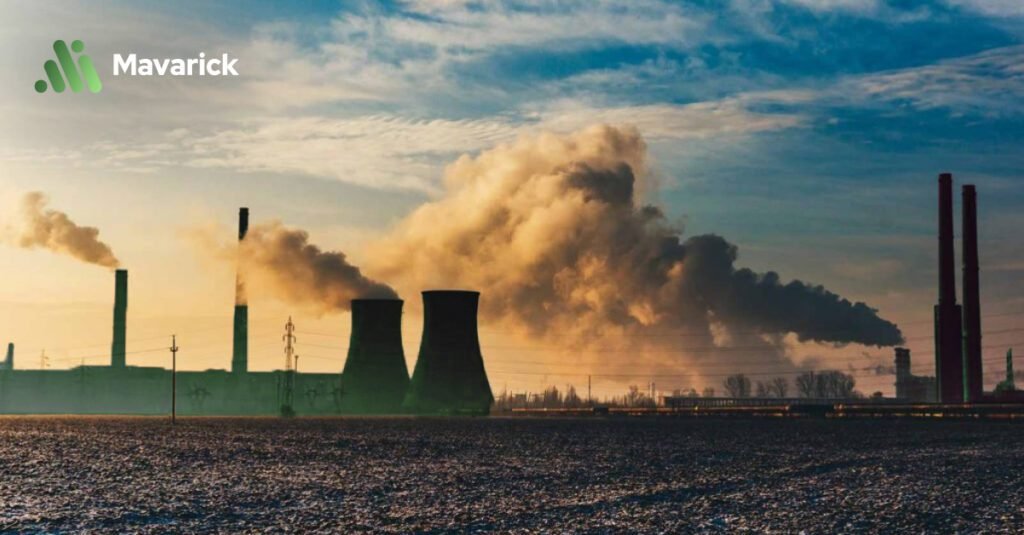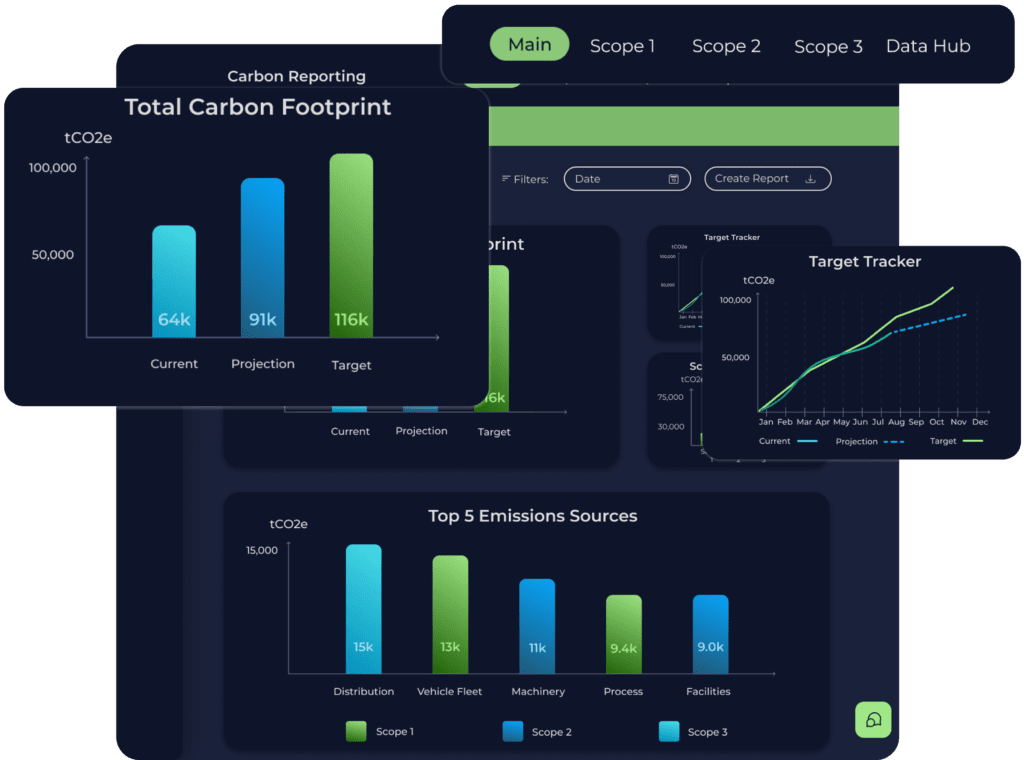
Table of Contents
- Why is Carbon Reporting Software Important?
- Questions to Consider Before Choosing a Carbon Reporting Tool
- 10 Tips to Choose the Best Carbon Reporting Software
- Understand Your Business Requirements
- Evaluate Integration Capabilities
- Assess Reporting Capabilities
- Prioritise Data Quality
- Consider Scalability
- Leverage Supply Chain Insights
- Ensure Audit-Readiness
- Analyse Cost and ROI
- Ensure User-Friendliness and Training Support
- Evaluate the Vendor’s Expertise and Support
- Conclusion
- Frequently Asked Questions (FAQs)
In today’s fast-evolving landscape, where sustainability has taken centre stage, businesses are increasingly adopting carbon reporting systems to measure and manage their carbon footprints effectively.
With global regulations such as the Corporate Sustainability Reporting Directive (CSRD) mandating detailed emissions disclosures, selecting the right carbon reporting software cannot be overstated. The right tool ensures compliance and provides insights to drive meaningful environmental impact. Read our blog on CSRD regulations to know more.
Coming to this blog, we will delve into 10 detailed tips for choosing the best carbon reporting tool to meet your organisation’s needs. By the end, you’ll be equipped with actionable insights and the confidence to make an informed decision.
Before we proceed, let us do a fact-check!
Globally, public companies are increasingly reporting their greenhouse gas emissions, with approximately 60% disclosing direct Scope 1 and Scope 2 emissions and over 40% reporting at least some Scope 3 (value chain) emissions, according to a recent report by MSCI. However, the report highlights a significant lag in climate reporting among U.S. companies compared to their global counterparts.






Why is Carbon Reporting Software Important?
The role of carbon reporting software has evolved beyond regulatory compliance. Modern tools enable businesses to build strategies, identify inefficiencies, and actively contribute to global climate goals. Whether you're managing Scope 1, Scope 2, or Scope 3 emissions, these systems provide robust support for accurate reporting and sustainability initiatives. Here’s why a carbon reporting tool is essential for businesses today:- Streamlined Data Management: Automated systems reduce the risk of errors associated with manual reporting and spreadsheets, ensuring data integrity and consistency across the reporting process. For more insights on the importance of data accuracy, check out our blog on 'Data Quality in Carbon Accounting'.
- Regulatory Compliance: Adhering to global standards like the CSRD has made compliance with frameworks such as the GRI, CDP, and TCFD increasingly essential. These frameworks guide companies in accurately disclosing their carbon emissions and sustainability efforts, ensuring transparency for stakeholders.
- Enhanced Transparency: Accurate and timely reporting fosters trust among investors, stakeholders, and customers.
- Strategic Decision-Making: Carbon reporting platforms like Mavarick offer granular insights into energy consumption patterns, emission hotspots, and supply chain inefficiencies.

Questions to Consider Before Choosing a Carbon Reporting Tool
This concise guide highlights the key questions to consider when assessing carbon reporting software:- What metrics does the software track, does it cover all 3 scopes?
- Is the platform aligned with the Greenhouse Gas Protocol (GHG Protocol)?
- How will the software free up internal resources?
- Is the software audit ready?
- Can the software be customised to monitor metrics specific to your business needs?
- How intuitive is the platform? Is it accessible for non-technical team members?
- Does the software scale effectively support company growth?

10 Tips to Choose the Best Carbon Reporting Software
Understand Your Business Requirements
Before exploring software options, identify your company’s specific needs. Are you focused on Scope 1 and Scope 2 emissions? Do you need supply chain-level analysis for Scope 3 emissions? If you are not sure, read our blog, Organisational Boundaries in Carbon Reporting to know more. Clear goals will help narrow down your options and ensure the software aligns with your needs, whether it’s for tracking, reporting, or strategic insights.Evaluate Integration Capabilities
Look for software that integrates seamlessly with existing enterprise systems like ERP and CRM. This ensures efficient data flow and reduces manual efforts. Not all carbon reporting tools are created equal. For industries like manufacturing, the complexity of supply chain emissions requires tools designed to handle granular data. For example, tools highlighted in this success story showcase how sector-specific features can simplify operations and ensure precise reporting.Assess Reporting Capabilities
Your software should support major frameworks like GRI, TCFD, and CDP to ensure compliance and transparency. Additionally, tools should facilitate reporting across organisational boundaries, which can be challenging without proper guidance. Learn more about this in our blog on organisational boundaries in carbon reporting.Prioritise Data Quality
High-quality data is essential for accurate reporting and meaningful analysis. Look for tools with automated data validation, integration capabilities, and error-detection mechanisms. Robust systems reduce manual errors and improve consistency. Learn why data quality in carbon reporting is a critical factor for credible sustainability efforts.
Consider Scalability
As your business grows, so will your reporting requirements. Choose a tool that scales with your organisation, accommodating new data streams, regions, and regulations. Scalable solutions are vital for businesses operating in industries with evolving compliance landscapes, such as energy and manufacturing.Leverage Supply Chain Insights
Effective carbon accounting software should provide deep visibility into supply chain emissions, particularly Scope 3, which often accounts for the largest portion of a company’s carbon footprint. Our blog on supply chain emissions explores how advanced tools can help track and reduce these emissions effectively.Ensure Audit-Readiness
Is your software ready for audit teams to come in and review? A robust carbon reporting tool should not only integrate seamlessly with existing systems like ERPs, IoT platforms, and energy management systems but also ensure audit-readiness by offering full traceability and compliance with global standards. Mavarick’s solution exemplifies this by providing accurate, transparent, and standardized climate reporting data that aligns with frameworks like the GHG Protocol. With features designed to consolidate data and support verification processes, it equips organizations to meet the rigorous demands of audits while fostering stakeholder trust.Analyse Cost and ROI
Investing in a carbon reporting tool isn’t just about compliance—it’s about long-term value. Tools that provide insights into cost-saving opportunities, such as energy efficiency incentives, can significantly boost ROI. Check out this blog on energy efficiency in manufacturing for insights on how emissions data can align with cost-reduction strategies.Ensure User-Friendliness and Training Support
No matter how advanced the software is, it must be intuitive for your team. Look for tools with user-friendly interfaces and robust customer support, including training modules. Proper training ensures that teams across departments can effectively utilise the software for their roles.Evaluate the Vendor’s Expertise and Support
Choose a vendor with proven expertise in carbon accounting, a strong customer success record, and ongoing support. A reliable vendor will help you navigate complex issues like double materiality and stay ahead of emerging regulations, ensuring your software investment delivers value for years to come. Now that you understand how to choose the best carbon reporting software, don't forget to explore our blog, Top 10 Carbon Accounting Platforms to find the solution that aligns perfectly with your organisation's needs.
Conclusion
Choosing the right carbon reporting software is a critical step toward achieving sustainability goals, ensuring compliance, and gaining actionable insights to drive meaningful change. By following these 10 steps, you can evaluate your organisation's needs, understand the nuances of data quality, and select a platform that simplifies emissions reporting while supporting long-term growth. Remember, the right tool isn’t just about meeting today’s regulatory requirements—it’s an investment in a more sustainable future. For a deeper dive, consider Mavarick—a cutting-edge platform designed to streamline carbon reporting and reporting for businesses across industries. It offers advanced features like automated data validation, seamless integration with enterprise systems, and robust supply chain emissions tracking. Take the first step toward better carbon management—discover Mavarick today!Frequently Asked Questions (FAQs)
- What is carbon reporting software, and why do I need it? Carbon reporting software helps businesses track, measure, and report their carbon emissions to meet compliance requirements and achieve sustainability goals.
- What key features should I look for in carbon reporting software? Look for features like real-time data tracking, integration with existing systems, automated reporting, Scope 1, 2, and 3 emissions tracking, and audit readiness.
- How can carbon reporting software help with regulatory compliance? It ensures adherence to standards like the GHG Protocol, CSRD, and other ESG frameworks by automating and validating carbon data for accurate reporting.
- Can carbon reporting software integrate with my existing tools and systems? Yes, most advanced software solutions offer seamless integration with ERPs, IoT platforms, and energy management systems for streamlined operations.
- What are the benefits of using carbon reporting software for my business? It simplifies emissions tracking, ensures compliance, enhances data accuracy, reduces manual effort, and helps align with sustainability goals to build stakeholder trust.
Carbon Accounting System
Carbon Emissions Reporting for the Supply Chain
- Visible Supply Chain
- Quality Data You can Trust
- Auditable Reports

